As one of the many culturally significant items on display at Harold Warp’s Pioneer Village in Minden, Nebraska, “Buffalo Bill” Cody’s saddle is quite literally a way to ride into the history of the frontier. This item is on display at Pioneer Village as a part of the Pony Express Station, where other items important to frontier times and the settlement of the West are also available to view.
Who Was Buffalo Bill Cody?
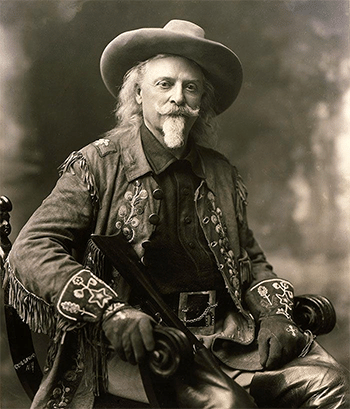
(Photo from centerofthewest.org)
Buffalo Bill Cody is most famously known for his Wild West show, named “Buffalo Bill’s Wild West,” although, he has many more accomplishments to his name than the western show. Born William F. Cody on Feb 26, 1848, “Buffalo Bill” Cody earned his nickname because of his reputation for being an expert marksman on the plains. According to Scott County, IA.’s website, William Cody got the name “Buffalo Bill” when he entered and won a shooting contest. Cody shot 69 buffalo to his opponent’s 46 buffalo, which ended up granting Cody both $500 in prize money and a nickname to solidify him in the pages of history. It was through this experience that Cody snagged a job as a civilian scout for the United States’ Army’s Fifth Cavalry, which consequently led to Cody starting his own western show. The show, named “Buffalo Bill’s Wild West,” was started by Cody in 1883 and featured exhibitions by the likes of Annie Oakley, Calamity Jane, Sitting Bull and other famous frontier figures who all presented alongside the skilled and energetic Cody. The show featured demonstrations of horse-riding, cattle-roping and mock battles between cowboys and Indians, and sharpshooting expositions as well, in which Cody took part in most of the events. The show became so popular that it even toured in Europe according to buffalobill.org, where Buffalo Bill performed for Queen Victoria herself as a part of the Golden Jubilee celebration in 1887. Buffalo Bill Cody was quoted as being the “hit of the show”, so much so that it was invited back and toured Europe again two years after its first visit. To bring in a local aspect, Buffalo Bill Cody largely considered the town of North Platte, Nebraska as his home. North Platte is roughly a two hour drive from Minden, Nebraska. As the hometown of a person as historically significant as William F. Cody, North Platte offers many Buffalo Bill themed experiences and places to see. (Photo from pbs.org)
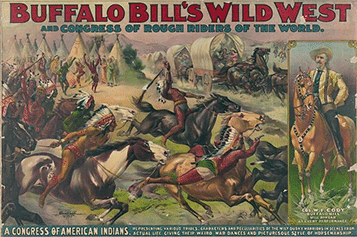
It should also be noted that Buffalo Bill Cody was also well known for his respect among Native Americans. Through Cody’s service in the U.S. Army, he earned and found respect amongst the Native tribes, and is quoted from buffalobill.org as stating that “The defeat of Custer was not a massacre. The Indians were being pursued by skilled fighters with orders to kill. For centuries they had been hounded from the Atlantic to the Pacific and back again. They had their wives and little ones to protect and they were fighting for their existence,” in regards to the Battle of Little BigHorn, where the famed Lieutenant Colonel George Armstrong Custer of the U.S. Army made his final stand and was killed by hostile native forces. Even given Cody’s respect for the Native American tribes of the plains, they oftentimes were still depicted as the aggressors in “Buffalo Bill’s Wild West” shows. Nonetheless, he still offered many Indians opportunities to leave reservations and represent their cultures according to buffalobill.org, showing his care for his former foes.
Back in the Saddle (Again)
Now that you know some background importance on Buffalo Bill Cody, the importance of his saddle can really be understood. The specific saddle on display at Harold Warp’s Pioneer Village is one of four variations of saddle that Cody used, which were made by Collins and Morrison of Omaha, Nebraska according to centerofthewest.org. In the book “Sister Clara’s Letters,” Harold Warp’s sister, Clara Warp Jensen, kept notes of when and where a large amount of the artifacts that she oversaw the acquisition of. Specifically, Buffalo Bill’s saddle was acquired in 1955 by Sister Clara, as quoted “from one Geo. Cobham.” It is also quoted as coming from “Valentino’s Estate” referring to 1920s actor Rudolph Valentino and was purchased alongside a painting of Buffalo Bill in his saddle, which is also currently displayed at Pioneer Village in the painting section of the Main Building. As stated earlier, Buffalo Bill Cody’s saddle can be viewed in the Pony Express Station building alongside other artifacts and items from American frontier expansion.
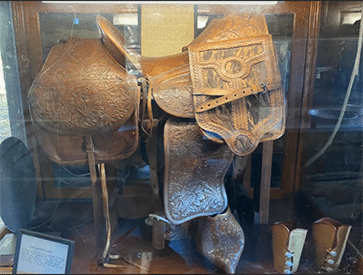
The saddle was used in “Scouts of the Prairie,” a show that included other well-known western figures such as “Texas Jack ” Omohundro and “Wild Bill” Hickcock. This show began Cody’s career in western shows. The main means to be able to ride a horse comfortably, a saddle, is very important to any horse rider, and especially for a man as storied as Buffalo Bill Cody. The saddle features leather on the back housing, and “Hon. W. F. Cody” engraved on the cantle. There are engraved designs on both fenders and all over the saddle. (For reference, a picture of western saddle parts and their names is provided.) Through the efforts of Harold Warp and all involved at the Harold Warp Pioneer Village, Buffalo Bill Cody’s saddle still exists today for all to see and marvel at, bringing thoughts of the wild west and America’s frontier to the minds of all who come to see it. Visit Pioneer Village to see this extraordinary historical artifact and stay to see the many others the Village has to offer!
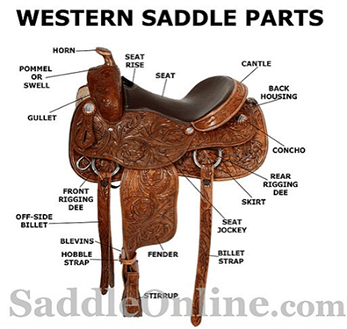
References:
- A Brief History of William F. “Buffalo Bill” Cody. Buffalo Bill Museum & Grave – Golden, Colorado. (n.d.). Retrieved October 26, 2021
- Buffalo Bill Biography. Buffalo Bill Center of the West. (2020, April 22). Retrieved October 26, 2021
- Buffalo Bill Cody History. Scott County, Iowa. (2016, June 14). Retrieved October 26, 2021
- Henry, A. M. (2021, July 13). Western Horse Saddle: Its parts and how long one should last. Horse Racing Sense. Retrieved October 26, 2021
- Home Page. City of North Platte. (2021, March 11). Retrieved October 27, 2021
- McClure, N. (2021, April 13). Treasures from our west: Saddle – Buffalo Bill Museum. Buffalo Bill Center of the West. Retrieved October 26, 2021
- Public Broadcasting Service. (n.d.). Buffalo Bill’s Wild West Show. PBS. Retrieved October 26, 2021
- Sister Clara’s Letters. Clara Warp Jensen and Harold Warp’s daily letters as compiled by Harold Warp. 1950-1962. Page 175.

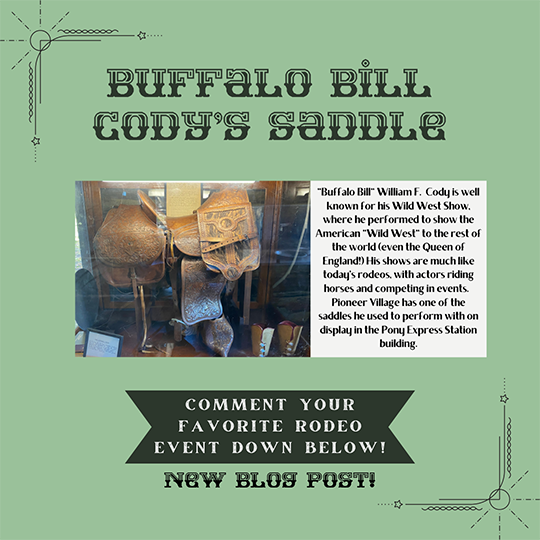
Recent Comments